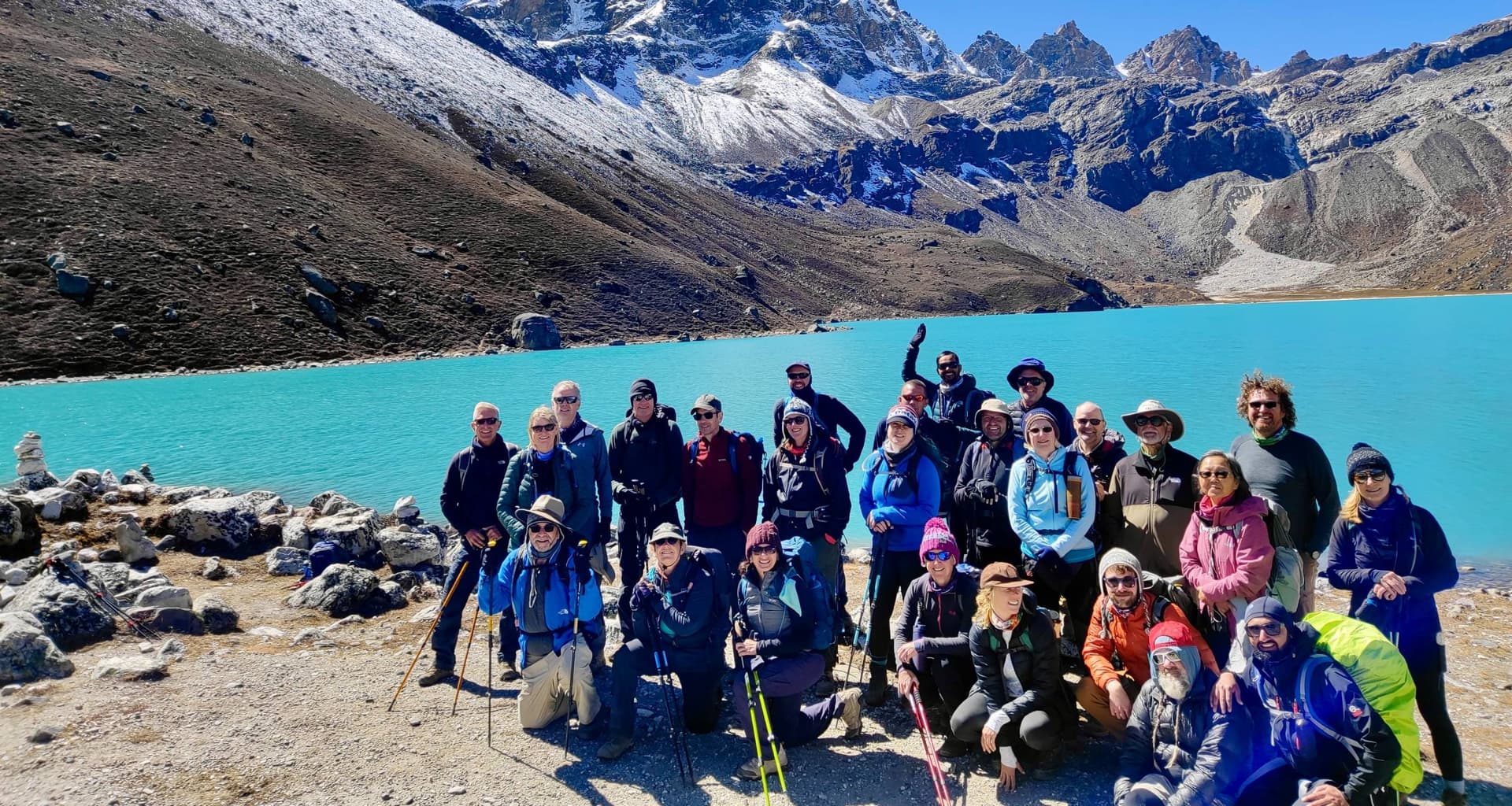Ever stared at a photo of Everest and thought, "Could I actually go there?" Yeah, me too. And guess what? You absolutely can. The Everest Base Camp and Gokyo Valley Trek isn't just for hardcore mountaineers with superhuman lungs.
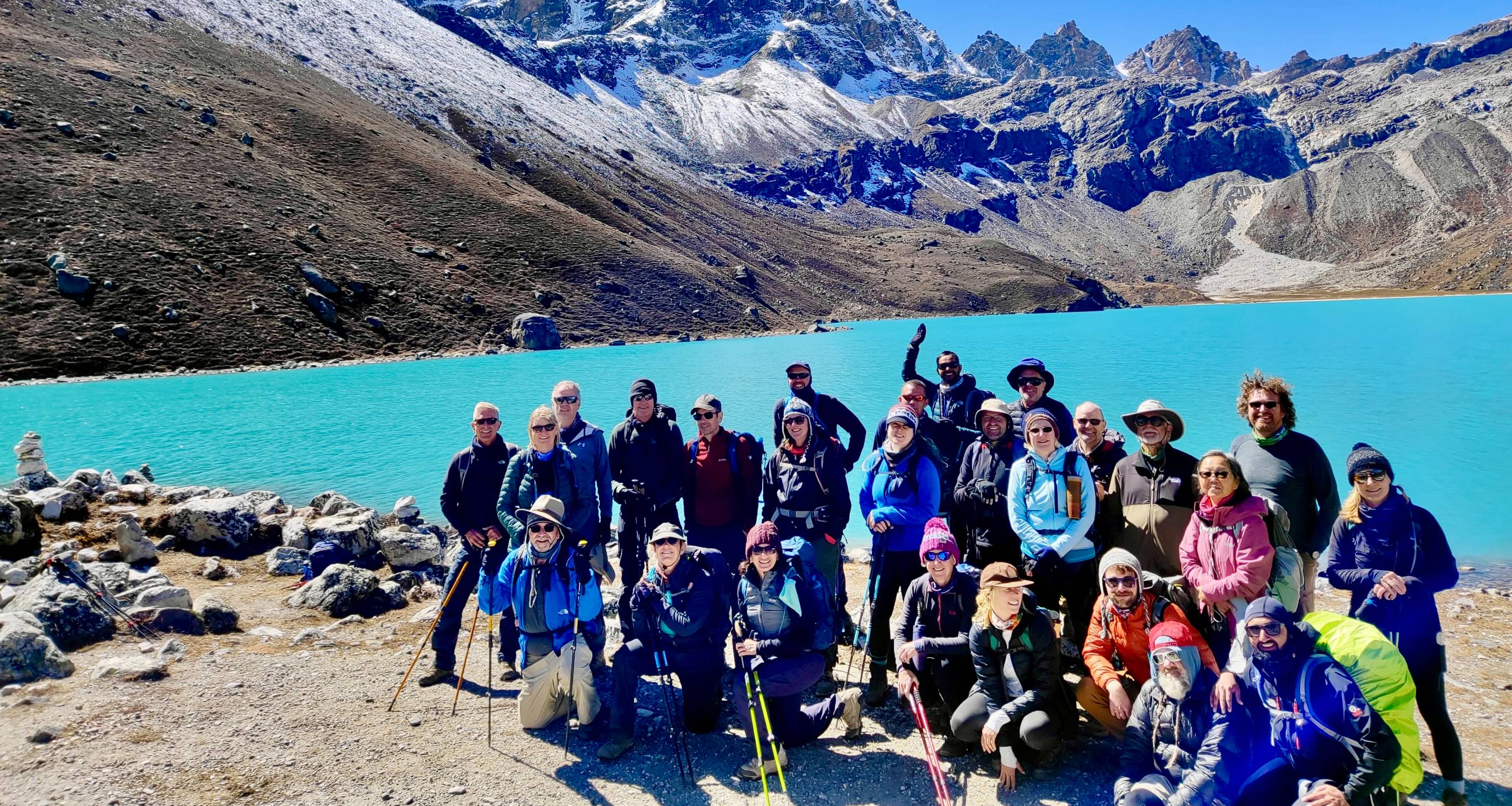
It's for anyone willing to put one foot in front of the other while surrounded by the most jaw-dropping mountain scenery on planet Earth.
I've guided hundreds of trekkers through these Himalayan giants, and I'm about to share everything I wish someone had told me before my first EBC trek. From acclimatization secrets to those little-known viewpoints where you'll capture photos that make your Instagram followers gasp.
But first, let me tell you about the morning I watched the sunrise from Kala Patthar. It changed everything I thought I knew about mountains...
Overview of the Everest Base Camp and Gokyo Valley Trek
Unique features of this combined trekking route
The Everest Base Camp and Gokyo Valley trek isn't your average Himalayan adventure. We've designed this route to give you the absolute best of the Khumbu region in one incredible journey. Unlike the standard EBC trek, our combined route takes you through the stunning Gokyo Valley with its turquoise lakes that shimmer like jewels against the dramatic mountain backdrop.
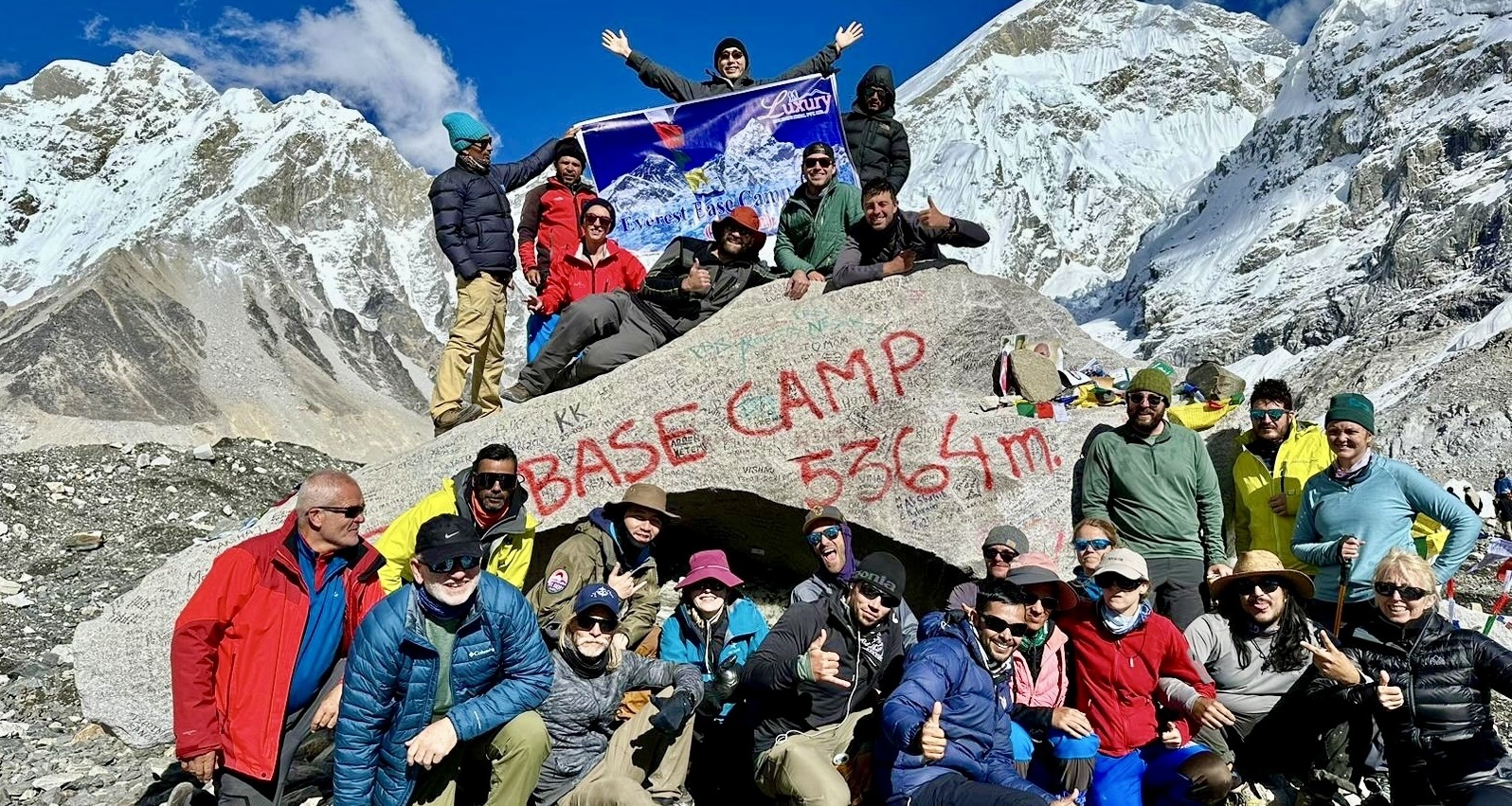
What makes this trek special? We cross the challenging Cho La Pass (5,420m), adding an exciting alpine element that most trekkers miss. Our route also includes Gokyo Ri, offering what we consider the most spectacular panoramic view of Everest - even better than Kala Patthar's famous outlook!
The trail is less crowded than the main EBC highway, especially in the Gokyo section. We've found this gives our clients a more authentic experience with local Sherpa culture in villages that haven't been as influenced by tourism.
Best seasons to undertake this adventure
We recommend two prime windows for this combined trek:
Spring (March to May): The rhododendron forests burst into bloom, painting hillsides in vibrant reds and pinks. Days are warming up, visibility is excellent, and those mountain views? Simply breathtaking.
Autumn (September to November): Our favorite time. Crystal-clear skies provide perfect visibility of the mountains. The weather stays stable, and temperatures are comfortable for trekking.
While summer brings monsoon rains, making trails slippery and winter delivers extreme cold at higher elevations, we can arrange treks year-round for those seeking specific experiences like solitude or snow-covered landscapes.
Duration and difficulty level
We classify this as a challenging trek, requiring:
- 14-18 days (including acclimatization days)
- Good physical fitness
- Previous trekking experience (recommended)
- Mental preparation for high altitudes
The route covers approximately 130km with significant elevation changes, reaching altitudes over 5,500m. We build in proper acclimatization days - not just rest days - with short hikes to higher elevations to help your body adjust safely.
Why choose Luxury Holidays Nepal as your guide
When trekking in the world's highest mountains, experience matters. We bring over 15 years of specialized knowledge to every expedition. Our guides are all local Sherpas who grew up in these mountains - they know every trail, weather pattern, and safety protocol.
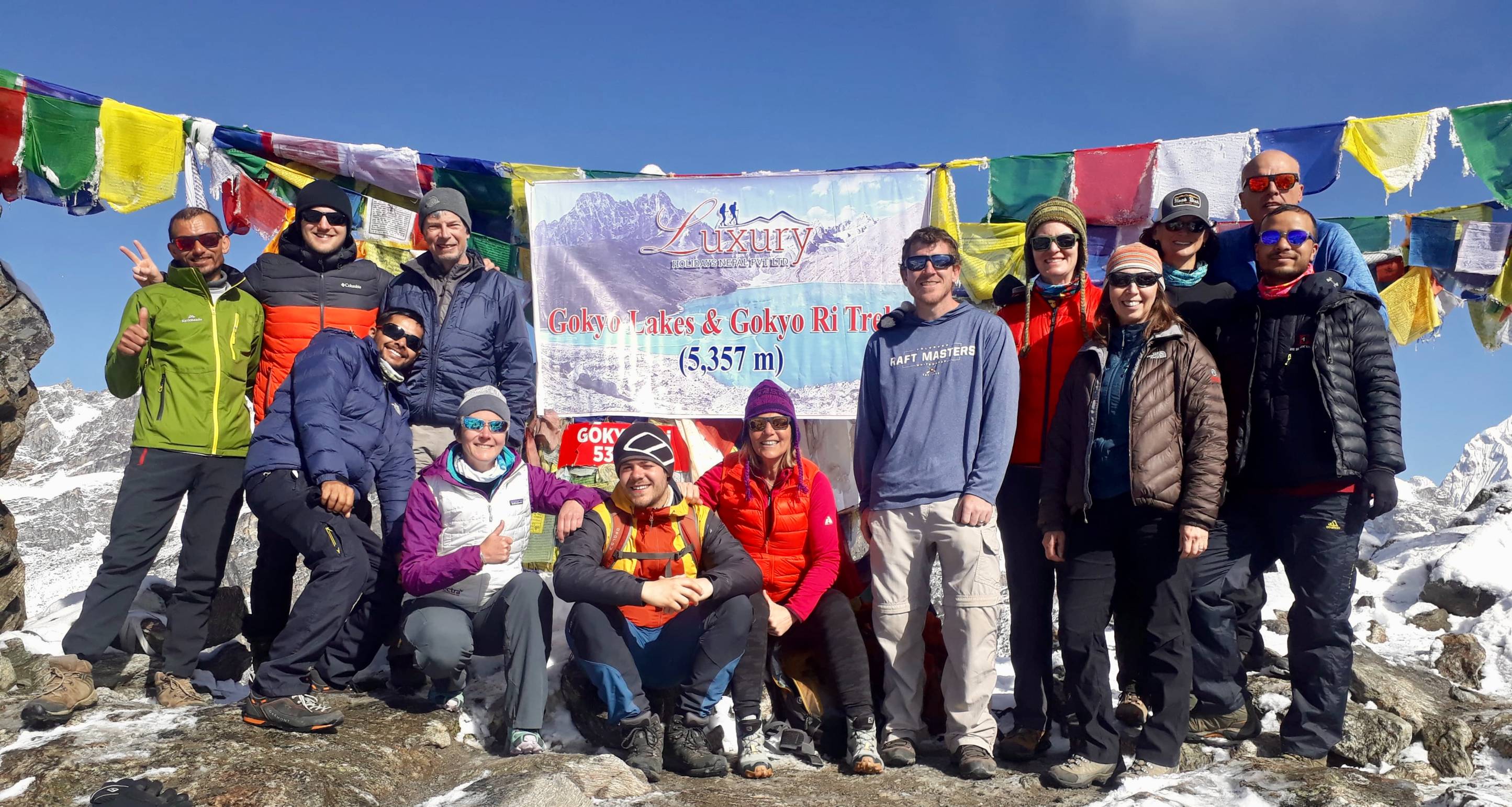
We keep our groups small (maximum 12) to ensure personalized attention and flexible itineraries. Our equipment is top-quality and regularly updated, from your sleeping bag to emergency oxygen supplies.
Beyond logistics, we create cultural connections. Our clients don't just see Nepal - they experience it through homestays, monastery visits, and authentic interactions with local communities. And we're committed to sustainable tourism, ensuring our operations benefit local economies while protecting fragile mountain environments.
Essential Preparation for Your Himalayan Journey
Physical Fitness Requirements and Training Tips
Trekking to Everest Base Camp and Gokyo Valley isn't a walk in the park. We recommend starting your fitness preparation at least 3-4 months before your trek.
Our experience shows that focusing on cardio endurance is crucial - aim for 45-60 minute sessions 4-5 times weekly. Mix in hiking, stair climbing, and cycling to build those leg muscles you'll rely on.
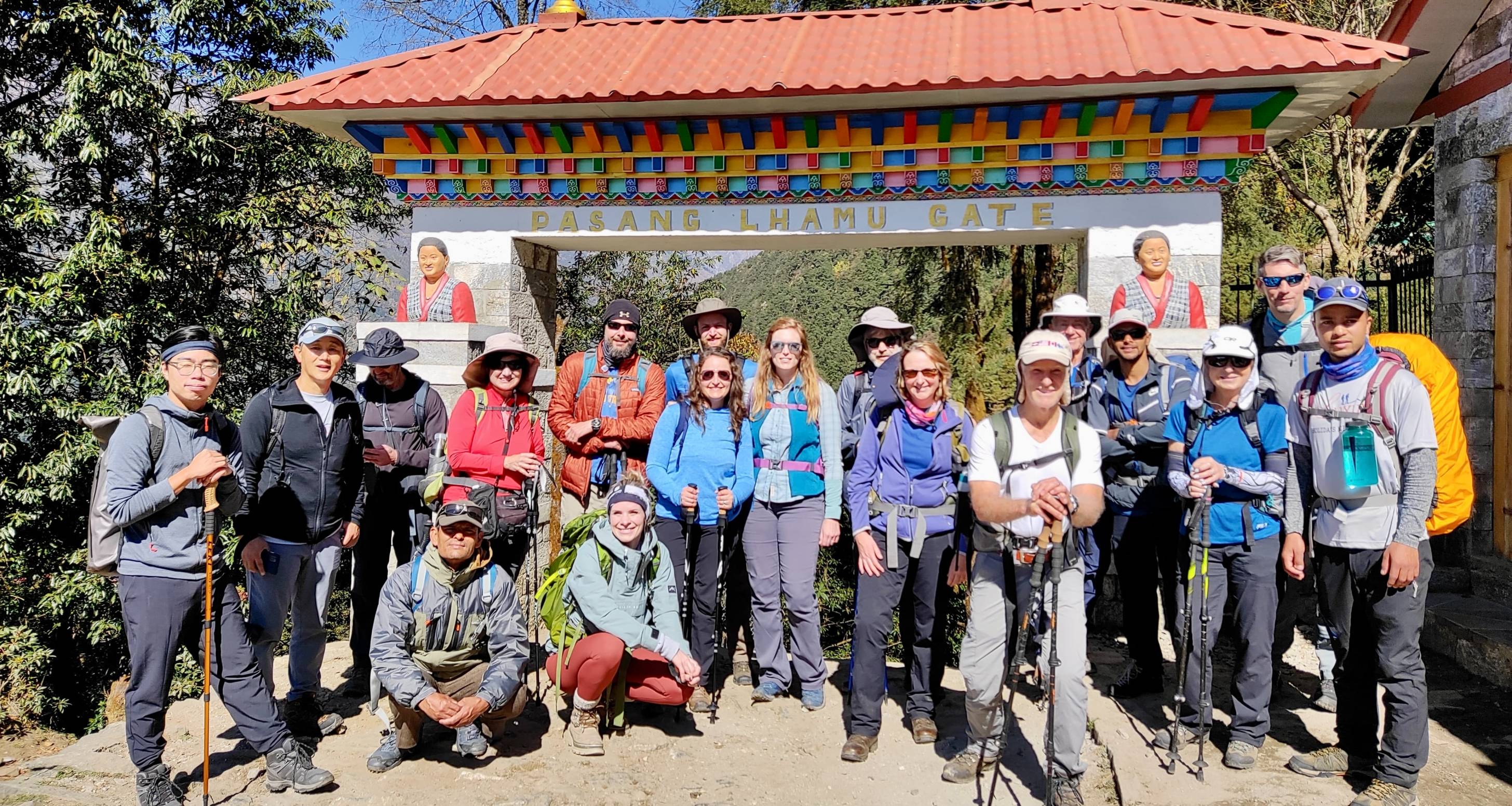
Strength training matters too! We've seen trekkers struggle when they skip this part. Include squats, lunges, and core exercises twice weekly. The stronger your legs and core, the better you'll handle those steep ascents and descents.
Weekend practice hikes make all the difference. We suggest gradually increasing duration and elevation gain, eventually working up to 6-8 hour hikes with a loaded backpack. This real-world training is gold for your body and mind.
Packing Checklist for Varying Altitudes
We've guided countless trekkers through these ranges and can't stress enough the importance of layering:
Base Layers:
- 2-3 moisture-wicking t-shirts
- 2 thermal long-sleeve tops
- 2 thermal bottoms
Mid Layers:
- 2 lightweight fleece jackets
- Hiking pants (convertible preferred)
- Fleece pants for evenings
Outer Layers:
- Waterproof/windproof jacket
- Waterproof pants
- Down jacket (essential for higher altitudes)
Footwear:
- Broken-in hiking boots with ankle support
- 4-5 pairs of wool trekking socks
- Camp shoes/sandals
Accessories:
- Warm hat and sun hat
- Gloves (lightweight and heavyweight)
- Buff/neck gaiter
- Sunglasses (UV protection)
- Headlamp with spare batteries
Don't forget sleeping gear! We recommend a -10°C sleeping bag as teahouse heating is minimal at higher elevations.
Understanding Altitude Sickness and Prevention
The biggest challenge on this trek isn't the distance - it's the altitude. We've seen strong hikers turned back because they rushed their ascent. Altitude sickness can affect anyone regardless of fitness level.
Symptoms to watch for:
- Headache (often severe)
- Nausea and vomiting
- Dizziness and fatigue
- Difficulty sleeping
- Loss of appetite
Our tried-and-true prevention strategy follows these principles:
- Slow ascent - we never increase sleeping altitude by more than 500m per day
- Rest days - we build in acclimatization days at Namche Bazaar (3,440m) and Dingboche (4,410m)
- Hydration - drinking 4-5 liters daily helps tremendously
- Medication - many of our trekkers take Diamox (acetazolamide) as a preventative
Remember our mantra: "climb high, sleep low" - day hikes to higher elevations followed by returning to lower altitudes for sleeping accelerate acclimatization.
Required Permits and Documentation
We handle the paperwork, but it's good to know what's required:
- Trekkers' Information Management System (TIMS) Card - $10 per person
- Sagarmatha National Park Entry Permit - $30 per person
- Khumbu Pasang Lhamu Rural Municipality Entrance Fee - $20 per person
All permits require passport-sized photos and copies of your passport. We recommend bringing extra photos and passport copies for unexpected situations.
Travel Insurance Considerations
We've seen enough emergency evacuations to be absolutely firm on this: comprehensive travel insurance is non-negotiable. Your policy must cover:
- High-altitude trekking (up to 5,600m)
- Emergency helicopter evacuation
- Medical expenses (minimum $100,000 coverage)
- Trip cancellation/interruption
Many standard travel policies exclude activities above 4,000m, so we specifically recommend providers like World Nomads, Allianz, or Global Rescue, who offer high-altitude coverage. The cost might seem steep ($150-200), but we've witnessed the alternative - a helicopter evacuation can cost $5,000-10,000 without insurance.
Always read the fine print and keep your insurance details, emergency contacts, and policy number accessible during the trek.
Detailed Day-by-Day Itinerary
Arrival in Kathmandu and preparation
We welcome you to the vibrant city of Kathmandu, where your Everest Base Camp and Gokyo Valley adventure begins! Upon arrival at Tribhuvan International Airport, our team meets you with a warm smile and transfers you to your hotel in the heart of the city.
Day 1 and 2 are dedicated to preparation and acclimatization. We gather for a comprehensive trek briefing where our experienced guides walk you through the entire journey, answer questions, and check your gear. Missing something? No worries! Thamel district has everything you need – from high-quality trekking poles to down jackets.
During these days, we explore Kathmandu's cultural treasures. Our guided tour takes us to Swayambhunath (Monkey Temple), the sacred Hindu temple of Pashupatinath, and Boudhanath Stupa – one of the world's largest Buddhist stupas. These visits not only introduce you to Nepal's rich heritage but also help you adjust to the local altitude before heading higher.
The flight to Lukla and beginning the trek
Day 3 starts with an early morning wake-up for one of the world's most thrilling flights – Kathmandu to Lukla (2,860m). The 35-minute journey offers breathtaking views of the Himalayas before landing at the famous Tenzing-Hillary Airport with its short, sloped runway.
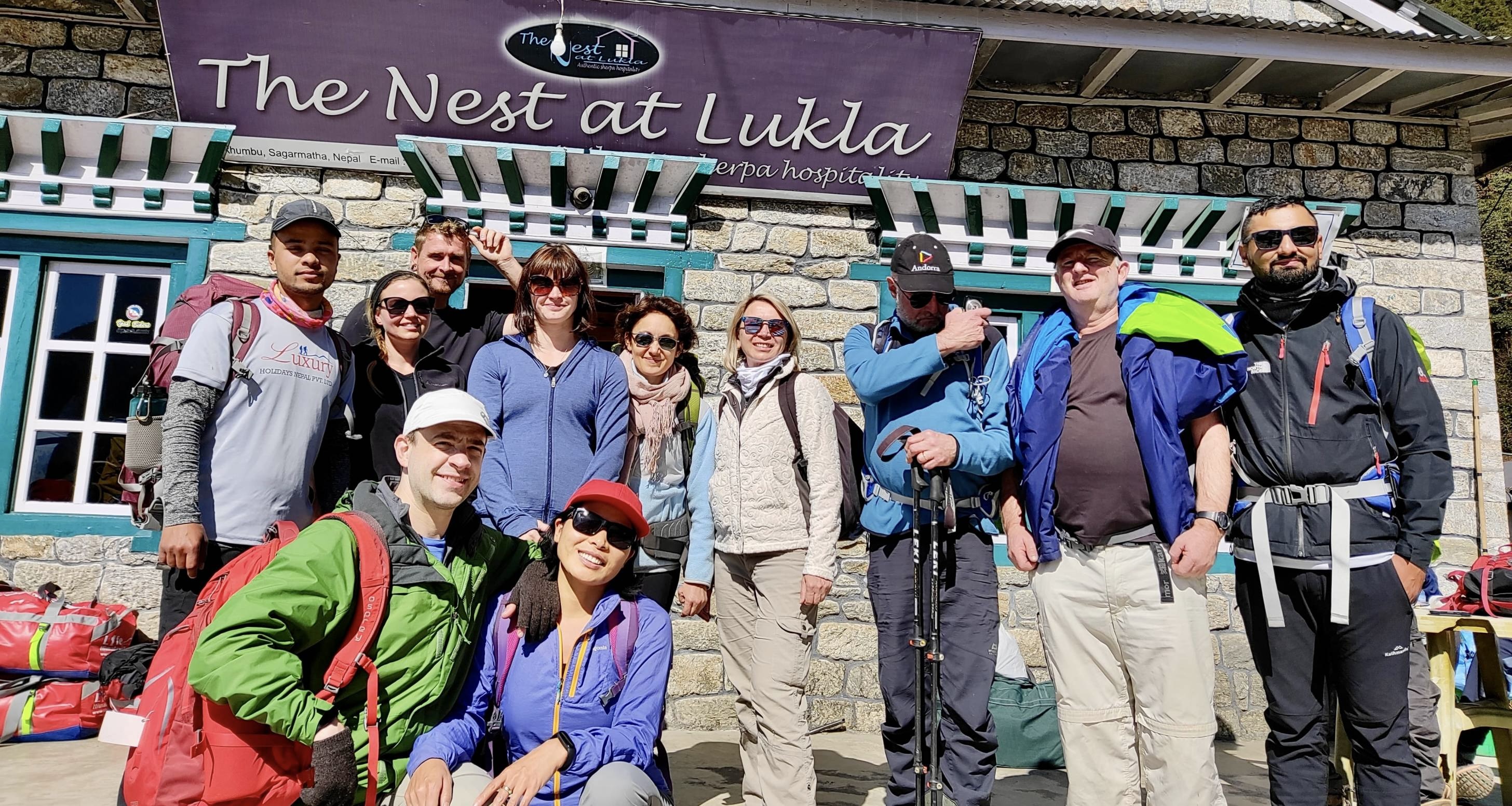
After meeting our porters and organizing our gear, we begin our trek through the charming town of Lukla. The trail leads us through rhododendron and pine forests as we follow the Dudh Koshi River. Our first day's trek is relatively gentle, allowing us to ease into the journey as we make our way to Phakding (2,610m). This picturesque village offers our first overnight stay in a tea house, where we enjoy a hearty meal and rest up for the more challenging days ahead.
Day 4 sees us trekking from Phakding to Namche Bazaar (3,440m), crossing suspension bridges draped with prayer flags and entering Sagarmatha National Park at Monjo. The final climb to Namche is challenging but rewards us with our first glimpse of Mt. Everest if the weather permits.
Key landmarks and overnight stops
Our journey takes us through some of the most spectacular landscapes and culturally significant places in the Khumbu region:
Namche Bazaar (3,440m) - The gateway to Everest and the largest settlement in the region. We spend two nights here, enjoying the bustling Saturday market, excellent bakeries, and stunning mountain views.
Tengboche (3,870m) - Home to the most important Buddhist monastery in the region. The panoramic views of Everest, Lhotse, Nuptse, and Ama Dablam from here are simply magical.
Dingboche (4,410m) - Our gateway to the Imja Valley with spectacular views of Island Peak and Ama Dablam.
Gokyo Valley (4,750m) - Famous for its turquoise lakes and offering one of the best views of Everest from Gokyo Ri (5,357m).
Cho La Pass (5,420m) - A challenging high mountain pass connecting the Gokyo Valley with the Everest Base Camp trail.
Gorak Shep (5,140m) - Our final overnight stop before Everest Base Camp, situated on a frozen lakebed.
Everest Base Camp (5,364m) - The culmination of our journey, with incredible views of the Khumbu Icefall.
Kala Patthar (5,545m) - Offering the best views of Mt. Everest's summit, usually climbed early morning for sunrise.
Acclimatization days and their importance
We don't rush this journey. Proper acclimatization is the key to both enjoying your trek and staying safe at high altitudes. That's why we include strategic acclimatization days at Namche Bazaar and Dingboche.
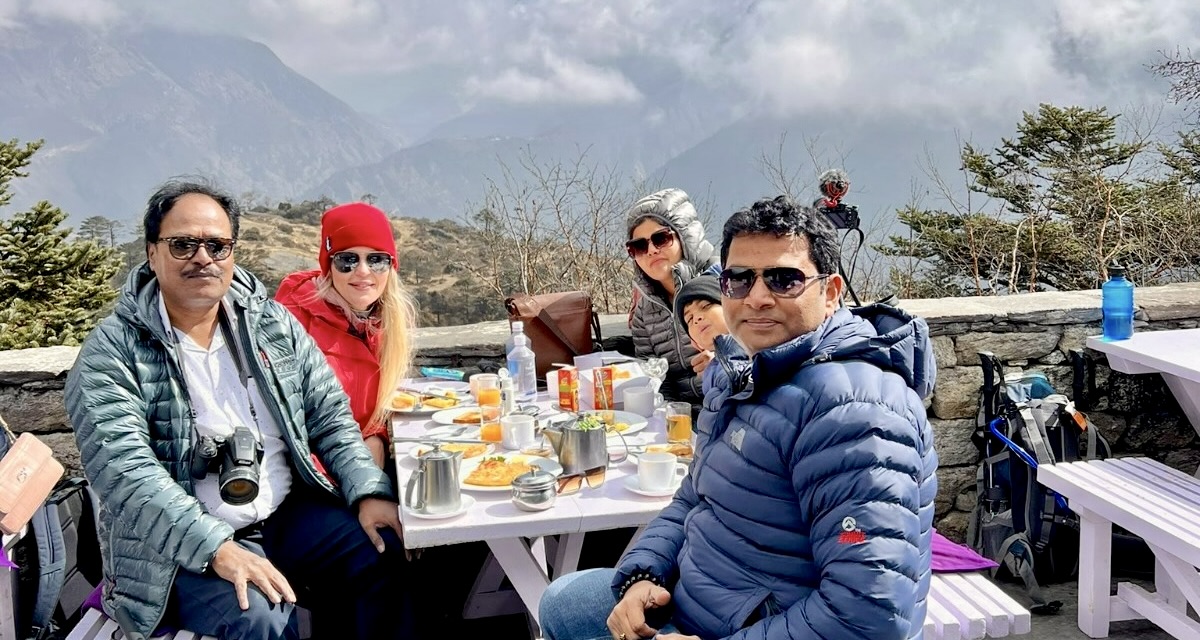
During these rest days, we don't actually rest! Instead, we follow the climber's mantra of "climb high, sleep low." We take day hikes to higher elevations, helping our bodies adapt to the thinning air, then return to sleep at lower altitudes.
In Namche, we hike to the Everest View Hotel (3,880m) for stunning mountain panoramas. In Dingboche, we climb to Nangkartshang Peak (5,083m). These acclimatization days also give us a chance to explore local villages, visit monasteries, and immerse ourselves in Sherpa culture.
Our guides constantly monitor everyone for signs of altitude sickness. We carry pulse oximeters to check oxygen levels and are trained in recognizing and addressing altitude-related issues. Remember, there's no shame in taking it slow – the mountains have stood for millions of years and will wait for you!
Highlights of the Everest Base Camp Trek
Tengboche Monastery and its cultural significance
Perched at 3,867 meters, Tengboche Monastery is a spiritual jewel on our Everest trek. We love watching trekkers' faces when they first glimpse this sacred Buddhist monastery against the backdrop of Everest, Lhotse, and Ama Dablam. The monastery isn't just pretty—it's the spiritual center of Khumbu.
We always time our visits to witness the monks' daily rituals. Their chanting echoes through the mountains, creating a mystical atmosphere that's impossible to describe. During the Mani Rimdu festival (October-November), we're treated to colorful masked dances and religious ceremonies that have remained unchanged for centuries.
Breathtaking views from Kala Patthar
Kala Patthar (5,545m) gives us the money shot we've been dreaming of. This black rocky outcrop offers the most stunning panorama of Everest you can get without technical climbing skills. We usually reach the summit for sunrise, when the first golden rays hit Everest's peak.
The 360° views are mind-blowing—Pumori, Nuptse, Lhotse, and of course, the mighty Everest. The perspective from here shows Everest in its full glory, something you don't even get at Base Camp itself.
Standing at the foot of Mt. Everest
Nothing compares to that moment we reach Everest Base Camp at 5,364 meters. After days of trekking, there's an indescribable feeling of achievement as we stand where legendary climbers began their summit attempts.
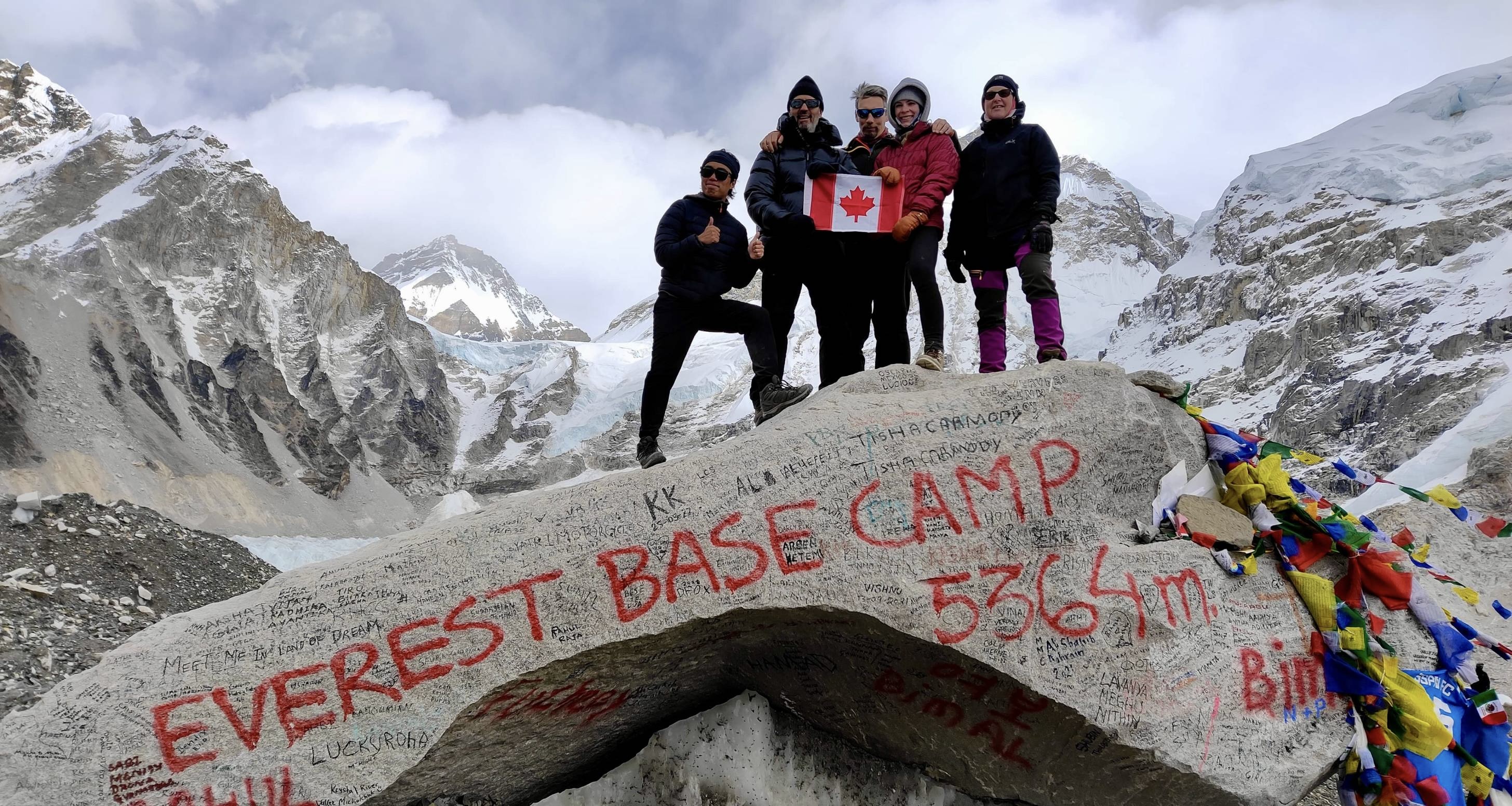
During climbing season, the camp buzzes with expedition teams preparing for their ascents. We love exploring the colorful tent city and sometimes chatting with climbers about their upcoming challenges. The massive Khumbu Icefall looms above—a stark reminder of the mountain's power and danger.
Exploring Namche Bazaar, the gateway to Everest
Namche Bazaar feels like stepping into another world. This horseshoe-shaped village is where we catch our first acclimatization break and dive into Sherpa culture.
The bustling Saturday market showcases everything from fresh produce to trekking gear. We always recommend our trekkers visit the Sherpa Culture Museum and Everest Photo Gallery to understand the region's rich history.
The bakeries serve the best apple pie at 3,440 meters—trust us, nothing tastes better after a tough hiking day! From Namche's viewpoints, we catch our first glimpse of Everest, fueling excitement for what's ahead on our journey.
Discovering the Gokyo Valley
The stunning turquoise Gokyo Lakes
We've trekked many trails in Nepal, but nothing quite compares to the moment when we first glimpse the turquoise waters of the Gokyo Lakes. These six glacial-fed lakes sit at elevations between 4,700-5,000 meters, creating an otherworldly landscape that stops trekkers in their tracks.
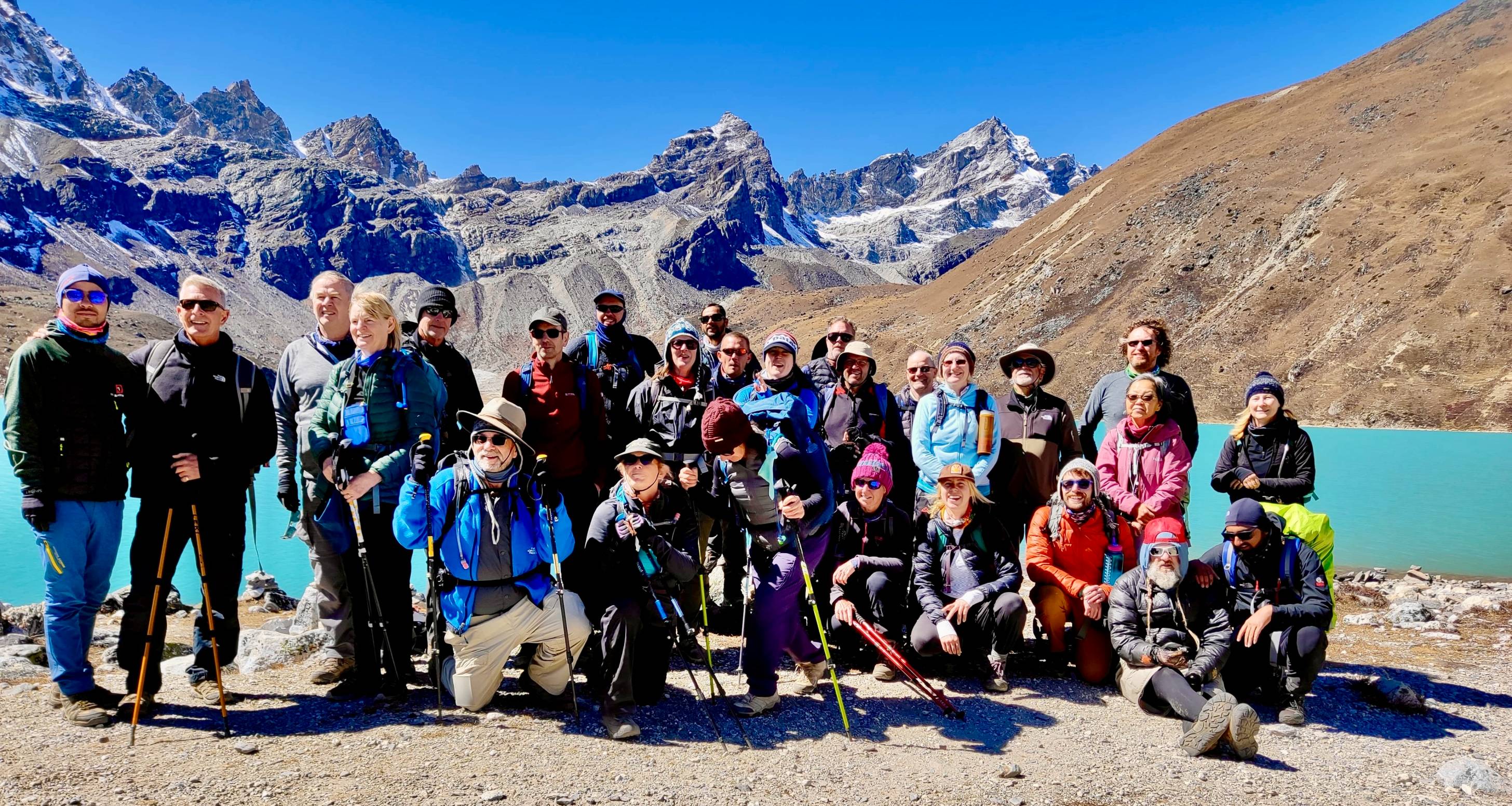
The third lake, Gokyo Cho (also called Dudh Pokhari), is where we typically spend the most time. The small settlement of Gokyo sits on its eastern shore, offering basic but comfortable teahouses where we can rest while soaking in the magnificent views. Early mornings here are magical – the still waters perfectly mirror the surrounding peaks before the day's winds pick up.
What makes these lakes truly special isn't just their striking color, but how they contrast with the stark, rocky landscape. We often find ourselves just sitting silently by the shoreline, watching the light change on the water throughout the day.
Panoramic views from Gokyo Ri
Hiking up Gokyo Ri (5,357m) is no small feat, but we promise it's worth every labored breath. We always start our ascent before dawn, headlamps lighting the zigzagging trail. The climb takes about 2-3 hours, depending on acclimatization and fitness levels.
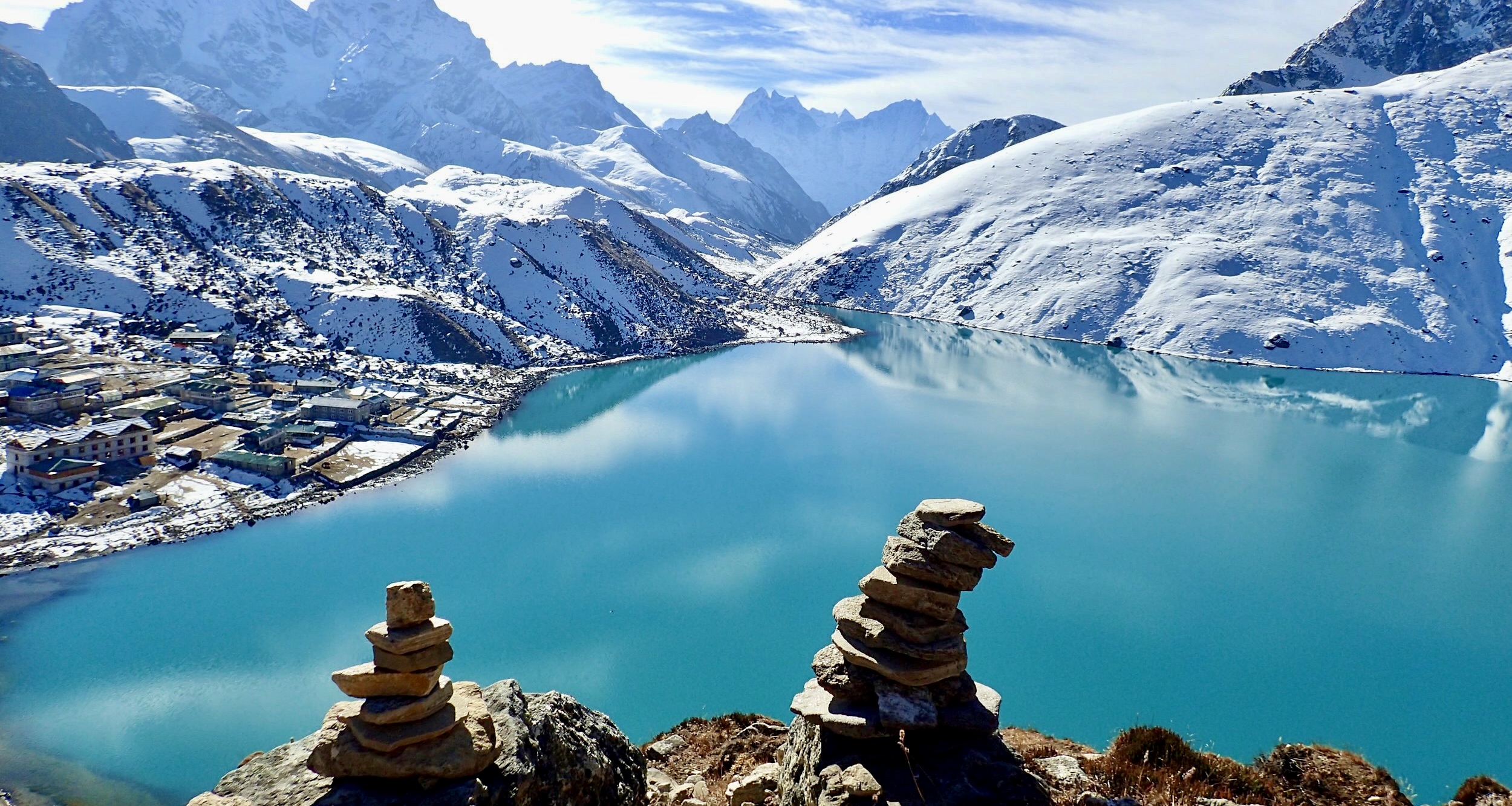
At the summit, we're rewarded with what many consider the finest mountain panorama in Nepal. Four 8,000m giants – Everest, Lhotse, Makalu, and Cho Oyu – stand before us in all their glory. The perspective of Everest from here offers something special that even the classic view from Kala Patthar can't match – you can see more of the mountain's structure, not just its famous black pyramid top.
The sprawling Ngozumpa Glacier (Nepal's largest) stretches below like a frozen river, while the Gokyo Lakes shimmer in various shades of blue. We always pack extra camera batteries for this viewpoint – you'll need them!
Crossing the challenging Cho La Pass
The Cho La Pass (5,420m) isn't for the faint-hearted. This challenging mountain pass connects the Gokyo and Everest Base Camp routes, and crossing it feels like a real adventure within our already epic journey.
We typically start from Thangnak (also called Dragnag) very early, as the crossing can take 7-9 hours depending on conditions. The initial climb is steep and rocky, leading to a glacier crossing that often requires microspikes or crampons, especially early in the season. The glacier section can be intimidating with its slippery ice and occasional crevasses, but our experienced guides ensure we navigate it safely.
The final push to the pass is marked by prayer flags fluttering in the wind – a welcome sight after hours of effort. The views from the top are spectacular, with Ama Dablam looking particularly impressive. The descent toward Dzongla is steep but gets easier as we leave the rocky terrain behind.
Unique flora and fauna of the region
The Gokyo Valley's high-altitude ecosystem hosts surprising biodiversity despite the harsh conditions. As we trek through different elevations, we witness the changing vegetation – from lush forests of pine, hemlock, and rhododendron in the lower regions to hardy shrubs, grasses, and beautiful alpine flowers higher up.
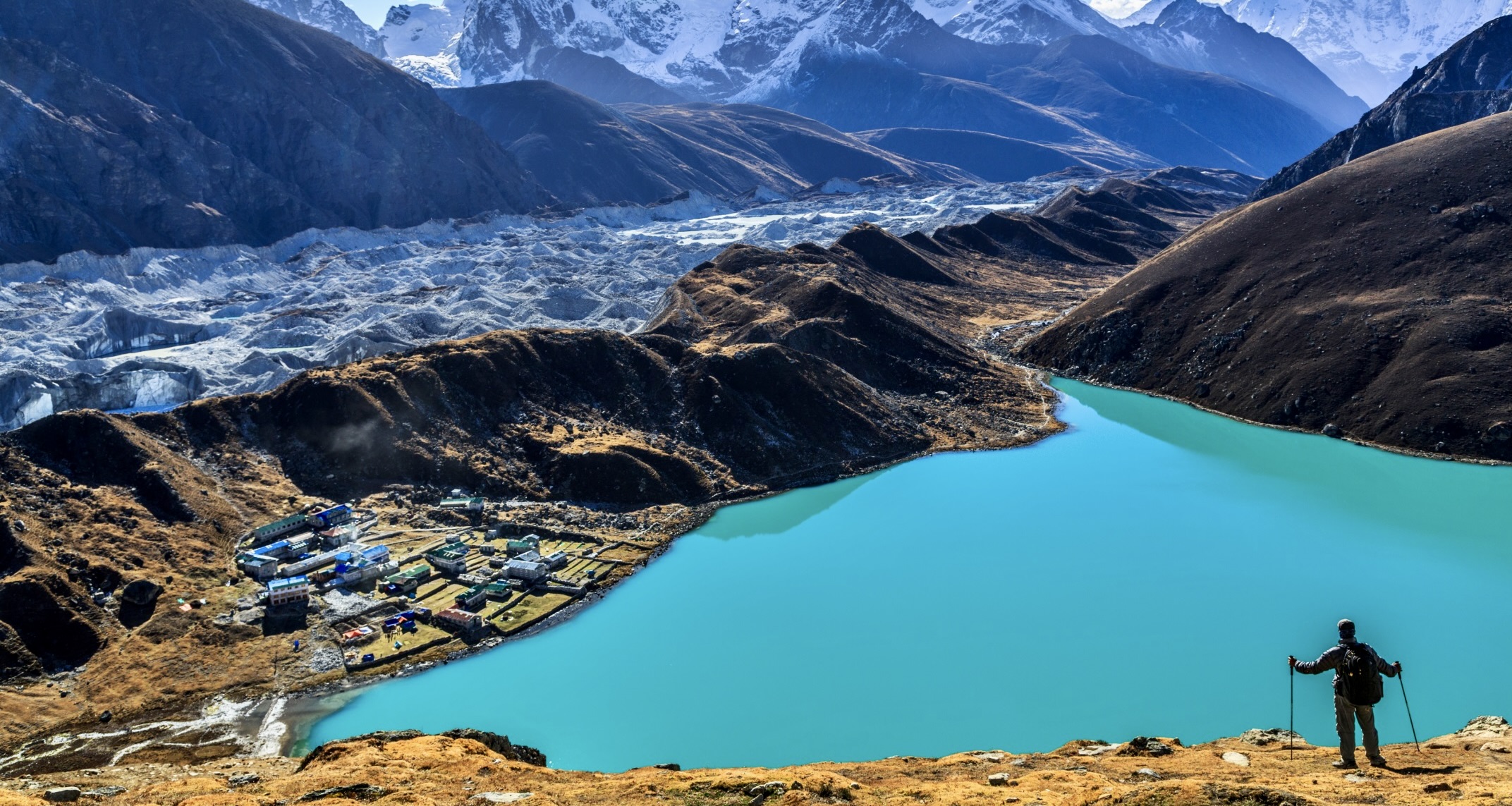
Spring trekkers (April-May) are treated to spectacular rhododendron blooms that paint entire hillsides in reds and pinks. Even above the tree line, we spot tiny but resilient wildflowers pushing through rocky ground.
Wildlife sightings add excitement to our journey. The Himalayan tahr (a wild goat) can often be spotted on steep slopes, while musk deer occasionally appear in forested areas. Lucky trekkers might glimpse Nepal's national bird, the colorful Danphe (Himalayan Monal).
The real wildlife prize is spotting the elusive snow leopard. While extremely rare, these magnificent cats do inhabit the region. We've never seen one ourselves, but we always keep our eyes peeled for paw prints in snow or dust. More common are pika (small rabbit-like creatures) that dart between rocks near the trails.
Accommodation and Dining Options
Teahouse Stays Along the Route
Teahouses are the backbone of trekking in the Everest region. We've found these simple but charming accommodations provide the perfect blend of basic comfort and authentic experience. Most teahouses offer private rooms with twin beds and shared bathrooms. Don't expect luxury - walls are thin, and hot water is often limited to certain hours (if available at all).
During peak season (October-November and March-May), we always recommend booking ahead as teahouses fill up quickly. Prices typically range from $3-10 per night, though we've noticed this often assumes you'll eat your meals at the lodge too.
The higher you climb, the more basic the amenities become. Above Namche Bazaar, electricity for charging devices becomes spotty and often comes with an hourly fee. Wi-Fi follows the same pattern - available but increasingly expensive as you ascend.
Luxury Lodge Alternatives
Not ready to rough it completely? We've got you covered. The Everest region now boasts several upscale lodges that offer a significant step up in comfort.
Properties like Mountain Lodges of Nepal and Everest Summit Lodges provide hot showers, electric blankets, and more refined dining options.
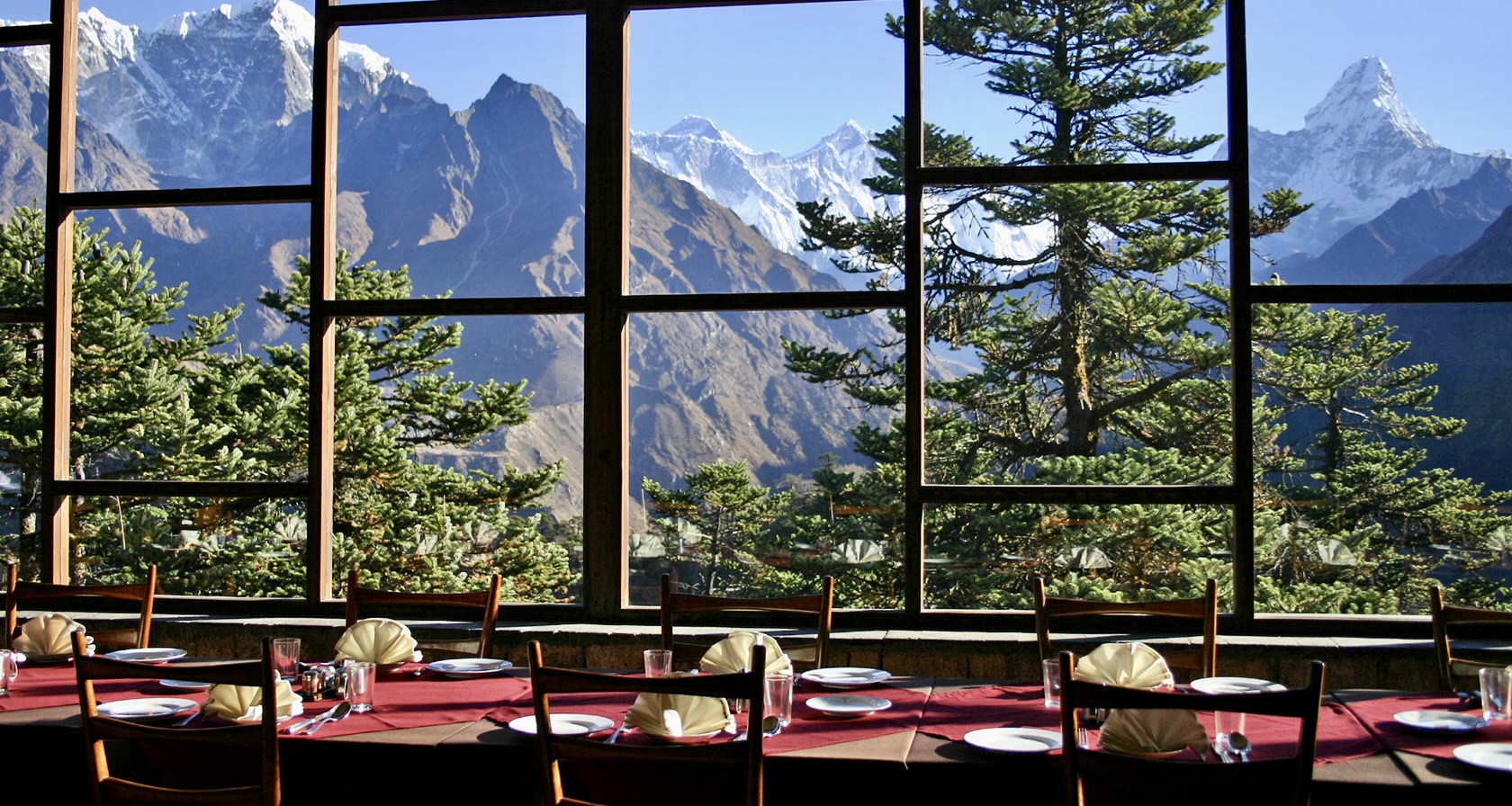
These luxury alternatives typically cost $100-200 per night but include proper beds with quality linens, en-suite bathrooms, and reliably heated rooms. Most importantly, after a grueling day of trekking, you'll have a genuinely comfortable place to recover.
The trade-off? You'll miss some of the social atmosphere of traditional teahouses, where trekkers gather around the central stove swapping stories. And luxury options don't extend to the highest portions of the trek.
Local Cuisine and Nutritional Considerations
The famous Dal Bhat (rice with lentil soup) isn't just delicious - it's the perfect trekking fuel. We always remind our clients that this local staple provides balanced nutrition and, importantly, unlimited refills to replenish those calories burned on the trail.
Most teahouses offer surprisingly varied menus including:
- Momos (Tibetan dumplings)
- Sherpa stew
- Potato dishes
- Noodle soups
- Basic Western options (pasta, pizza, sandwiches)
We strongly recommend focusing on carbohydrates to maintain energy levels at altitude. Protein is important for recovery, but harder to digest at high elevations. Aim for 3,000-4,000 calories daily, significantly more than your normal intake.
Vegetarians will find plenty of options, while strict vegans might find more limited choices the higher they go.
Clean Water and Food Safety Tips
Waterborne illness can derail even the best-planned trek. We never drink unfiltered water and don't recommend you do either. Options we use include:
- Water purification tablets (effective but leave an aftertaste)
- SteriPEN or UV purifiers (quick but require batteries)
- Filter bottles like LifeStraw (convenient but can clog)
- Buying boiled water at teahouses (reliable but creates plastic waste)
For food safety, we stick to freshly cooked, hot meals and avoid raw vegetables at higher elevations where water for washing may not be adequately purified. Peelable fruits are generally safe.
Temperature drops dramatically at night, so teahouses don't typically have refrigeration. This means meat becomes increasingly scarce (and questionable) above Namche Bazaar. We usually switch to vegetarian options above 4,000 meters just to be safe.
Cultural Encounters on the Trek
Sherpa communities and their traditions
Trekking through the Everest and Gokyo region isn't just about stunning landscapes—it's about meeting the incredible Sherpa people who call these mountains home. We've spent countless hours in Sherpa villages like Namche Bazaar, Khumjung, and Thame, where generations of families have maintained their unique way of life.
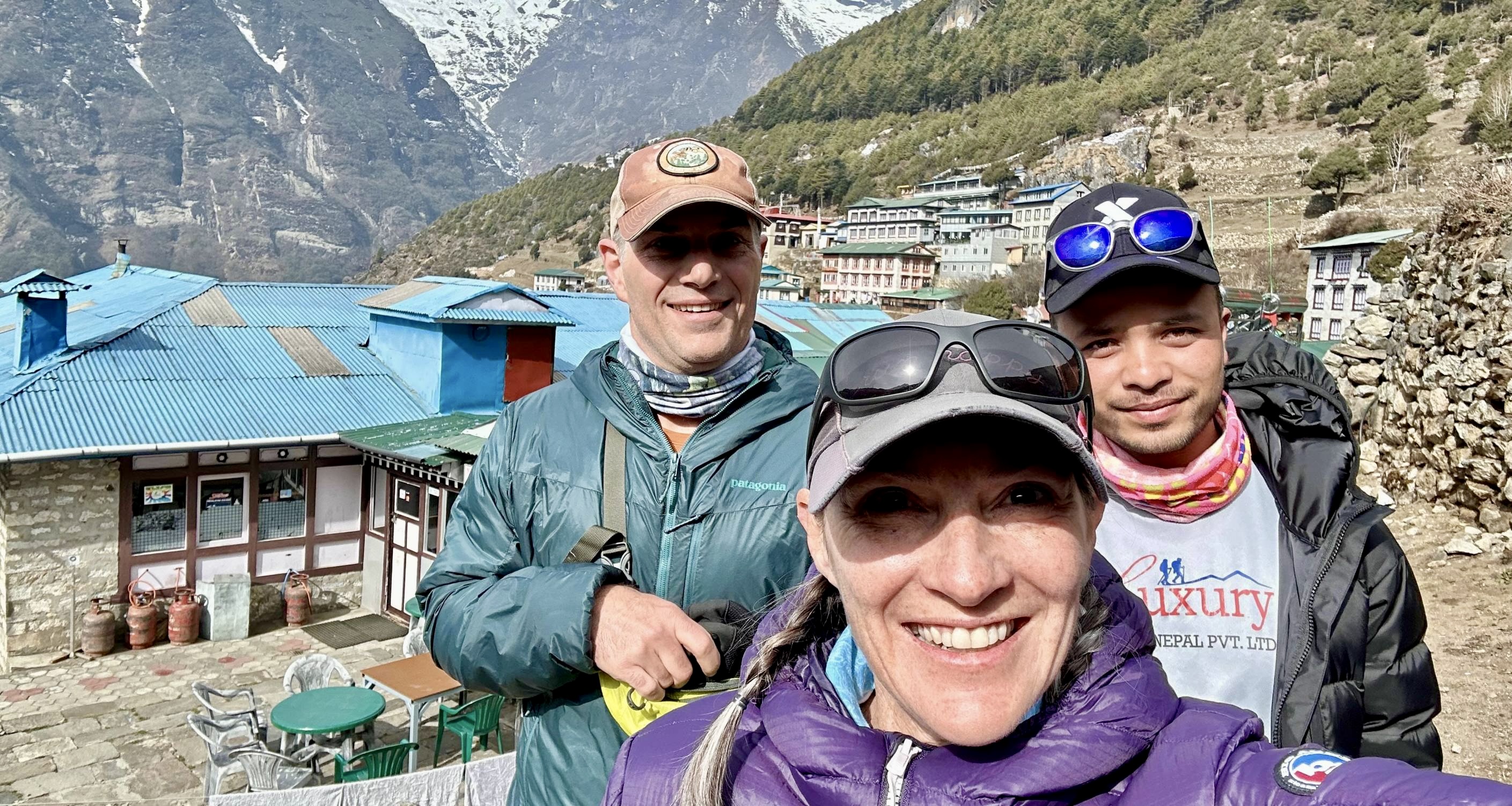
Sherpas are world-renowned for their mountaineering skills, but there's so much more to their culture. Their homes feature traditional architecture with colorful prayer rooms (gompa) where family members gather. Most meals center around tsampa (roasted barley flour), butter tea, and chang (mildly alcoholic brew)—staples that fuel their high-altitude lifestyle.
Marriage ceremonies, naming rituals, and agricultural practices all follow ancient traditions that have barely changed over centuries. We always recommend joining a local family for a meal if invited—it's the perfect way to experience genuine Sherpa hospitality!
Buddhist monasteries and prayer flags
The vibrant flutter of prayer flags against snowy peaks is something we never tire of. These colorful flags aren't just for show—they carry prayers and mantras on the wind, spreading goodwill across the valleys.
Tengboche Monastery stands as the spiritual center of the Khumbu region. Founded in 1916, this sacred place offers a glimpse into living Buddhist traditions. We try to time our visits during morning or evening prayers when monks fill the halls with haunting chants and ceremonial horns.
In Khumjung, the monastery houses what locals claim is a "yeti scalp"—definitely worth a quick look! The Pangboche Monastery contains ancient relics believed to be over 700 years old. We're always moved by the quiet dedication of monks who maintain these sacred spaces at such extreme altitudes.
Local festivals and celebrations
If you're lucky enough to visit during festival season, you're in for an unforgettable cultural experience. The Mani Rimdu festival at Tengboche (October/November) features three days of masked dances, ritual ceremonies, and celebrations that bring the entire community together.
Losar (Tibetan New Year) transforms villages with prayer sessions, family gatherings, and special foods. The Dumje Festival honors the birthday of Guru Rinpoche, who brought Buddhism to the region.
We've joined locals during these celebrations and been amazed at their generosity in sharing these sacred moments. The dancing, vibrant costumes, and joyful atmosphere create memories that last far longer than photos of mountain peaks.
Respectful interaction with local customs
Navigating cultural differences requires thoughtfulness, but a little respect goes a long way. We always walk clockwise around religious monuments (mani stones, stupas, prayer wheels) following Buddhist tradition.
When visiting monasteries, we remove our shoes and avoid touching religious objects without permission. Photography is usually allowed, but always ask first, especially during ceremonies.
Offering a small donation when visiting monasteries helps maintain these ancient institutions. Using basic Nepali or Sherpa greetings ("Namaste" or "Tashi Delek") instantly creates goodwill.
We've found that showing genuine interest in local customs opens doors to authentic connections. The people of this region face unique challenges living at altitude, yet their warmth and spirituality create an experience that's just as breathtaking as the mountains themselves.
Photography and Memorable Experiences
Best Photography Spots and Timing
The Everest Base Camp and Gokyo Valley Trek offers some of the most jaw-dropping photo opportunities on planet Earth. We've found that Kala Patthar (5,545m) provides the absolute best vantage point for capturing Everest's magnificent peak. The golden hours just after sunrise (between 6-7am) create this magical light that makes the mountains glow.
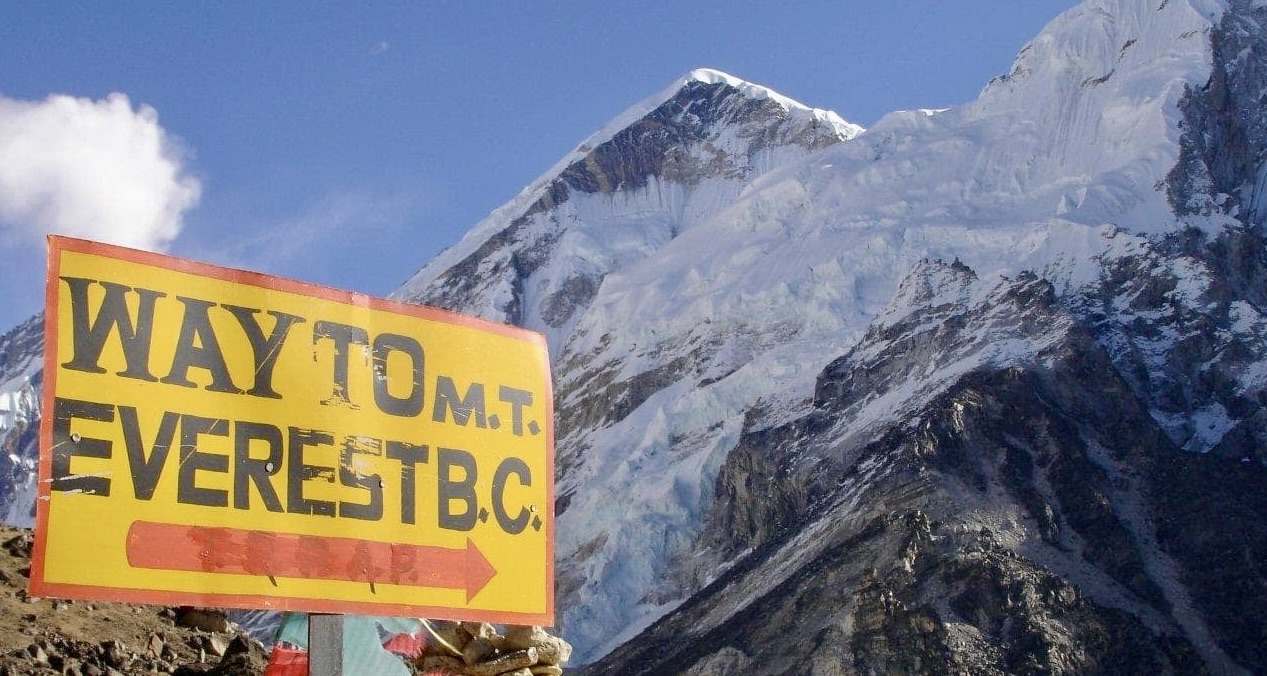
Another spot we never miss is the viewpoint above Gokyo Lakes. Those turquoise waters against the stark mountain backdrop? Pure magic through a lens. For the most dramatic shots, we aim to be there around 3-4pm when the light softens but still highlights the vivid colors.
Don't overlook Tengboche Monastery! We always time our visit for evening prayers (around 3pm) when monks gather and the warm interior lighting creates incredible portrait opportunities with Ama Dablam looming in the background.
Capturing the Changing Landscapes
Trekking through this region is like walking through four seasons in two weeks. We start in the lush, green valleys near Lukla, where the light filters through the forest canopy—perfect for shooting in the mid-morning when fog lifts but before harsh midday sun.
As we climb higher, the landscapes transform dramatically. The rhododendron forests between Namche and Tengboche burst with color in spring (March-May), creating stunning foreground elements against mountain backdrops.
Above Namche, the terrain becomes increasingly rugged. We've learned to use the stark contrast between snow-capped peaks and rocky moraines to create depth in our photos. Shooting panoramas at Dzonglha pass showcases this transition beautifully.
The Ngozumpa Glacier near Gokyo offers alien-like landscapes with ice formations and small pools. We find shooting these with a wide-angle lens during midday minimizes harsh shadows in the ice crevasses.
Wildlife Photography Opportunities
Though not abundant, wildlife spotting adds serious excitement to our treks! The elusive snow leopard remains the holy grail (we're still waiting for that perfect shot), but more commonly, we encounter Himalayan tahr perched on seemingly impossible cliffsides.
The Danphe (Nepal's national bird) with its rainbow plumage makes for spectacular photos when spotted in the forests below Namche. We carry telephoto lenses (at least 300mm) specifically for these moments.
Red pandas occasionally appear in the forested areas around Phakding and Monjo. They're most active early morning or late afternoon. Our tip: move slowly, listen for rustling in the trees, and always have your camera settings ready for low light and quick movement.
Birds of prey soaring against mountain backdrops create dramatic silhouettes. We've captured stunning shots of Himalayan griffon vultures riding thermals near Machhermo, especially around midday.
Tips for Protecting Your Equipment in Extreme Conditions
Battery life becomes your worst enemy at high altitudes. We always carry at least 3-4 spare batteries and keep them close to our bodies during cold nights. Nothing's worse than missing that perfect sunrise because your last battery died!
Condensation kills cameras. When moving between warm teahouses and freezing outdoors, we never immediately open our camera bags. Instead, we let everything gradually adjust to the new temperature, sometimes waiting 15-20 minutes before taking equipment out.
Dust is everywhere on the trail. We bring multiple microfiber cloths and a small rocket blower to clean sensors and lenses. Changing lenses? We always face away from the wind and do it as quickly as possible.
The dry air at altitude can create static electricity that attracts dust to sensors. A simple hack we use: rubbing a tiny bit of anti-static solution on the outside of our camera bags reduces this problem significantly.
For extra protection during unexpected rain or snow, we pack lightweight silicone covers for our cameras. They weigh almost nothing but have saved our gear countless times when weather changed suddenly.
Luxury Services Offered by Luxury Holidays Nepal
Private guides and porters
At Luxury Holidays Nepal, we believe your Everest journey should be as seamless as it is memorable. Our private guides aren't just navigators—they're storytellers, local experts, and safety professionals rolled into one. Each guide brings at least 10 years of Himalayan experience, comprehensive first aid training, and fluent English skills.
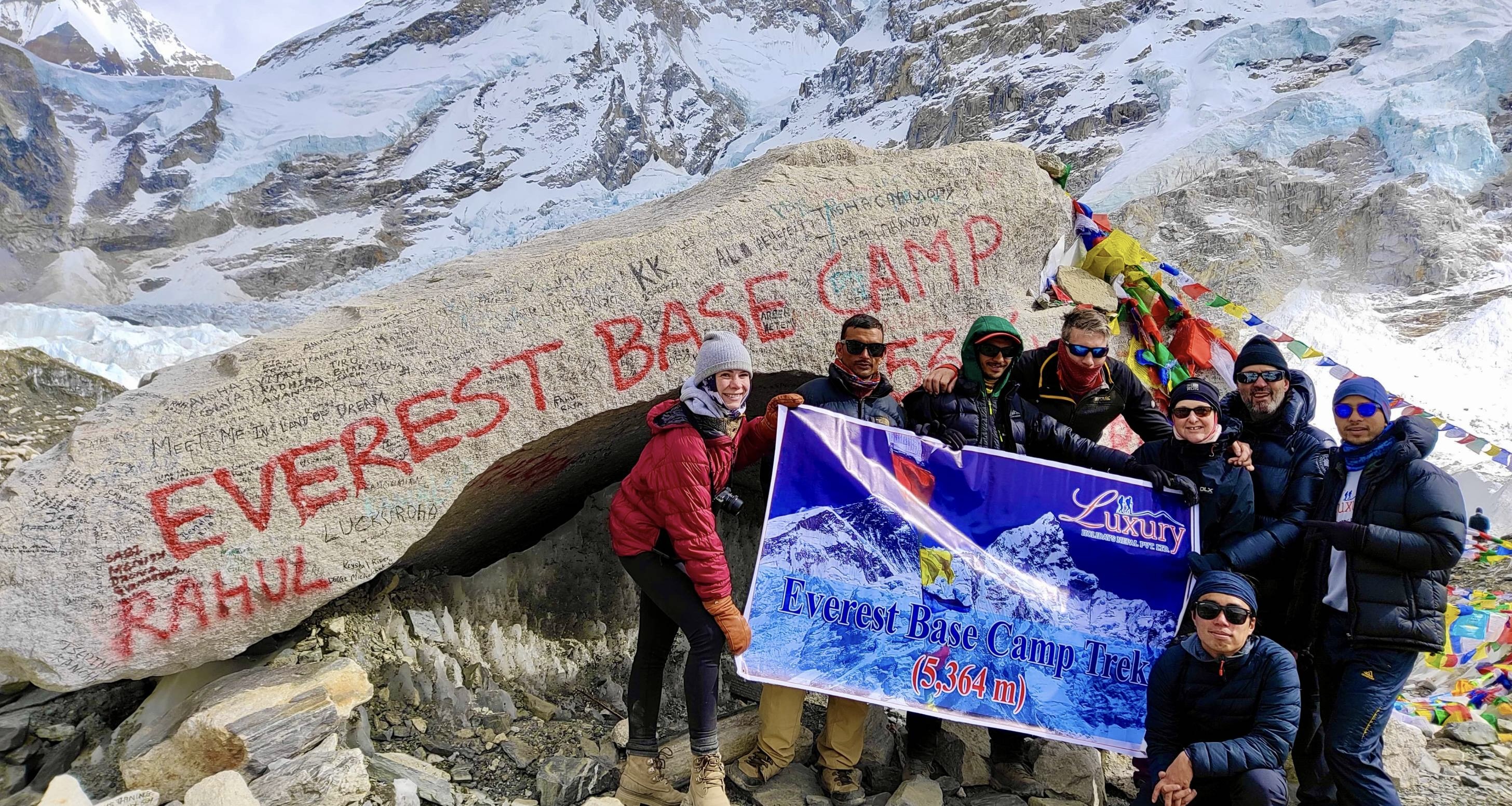
We maintain a 1:2 guide-to-client ratio, ensuring personalized attention throughout your trek. Our porters are the unsung heroes of the mountains, carefully selected and professionally equipped. They carry up to 20kg of your gear, allowing you to focus on the breathtaking landscapes rather than your backpack.
Helicopter evacuation options
The Himalayas demand respect, and we respect your safety above all. Every trek includes emergency helicopter evacuation insurance—not as an add-on, but as our standard. Our guides carry satellite phones and GPS devices for immediate communication in remote areas.
If altitude sickness or injury strikes, we don't waste precious time. One call activates our Kathmandu-based emergency response team, who can dispatch a helicopter to your location within hours, weather permitting. This service isn't just for emergencies—some clients choose our "Trek Up, Fly Down" option to experience the mountains without the descent journey.
Customized itineraries for different needs
Your dream Everest adventure is uniquely yours. Whether you're a photographer needing extra time at Kala Patthar for that perfect sunrise shot, a family with young trekkers requiring a gentler pace, or a seasoned mountaineer seeking challenging side trips, we build itineraries around you.
Our pre-trek consultations dig deep into your fitness level, previous altitude experience, and personal interests. Want to include a meditation session with monks at Tengboche Monastery? Interested in visiting a local school? Looking to extend your acclimatization days? Just ask—we make it happen.
Additional comfort amenities
The stereotype of roughing it in the mountains? We've redefined that. Our luxury treks include:
- Premium sleeping bags rated to -20°C
- Extra-thick sleeping mats
- Hot water bottles for chilly nights
- Portable shower systems at select locations
- Private toilet tents with eco-friendly disposal
- Solar charging stations for your devices
- Supplemental oxygen available on request
- Gourmet meal upgrades featuring local and international cuisine
- Evening tea service with freshly baked treats
These aren't extravagances—they're the foundations of a comfortable journey that lets you appreciate Everest's grandeur without unnecessary discomfort.
Post-trek relaxation packages
After conquering Everest Base Camp and Gokyo, your body deserves some TLC. Our post-trek packages transform the final days of your Himalayan adventure into a rejuvenating retreat.
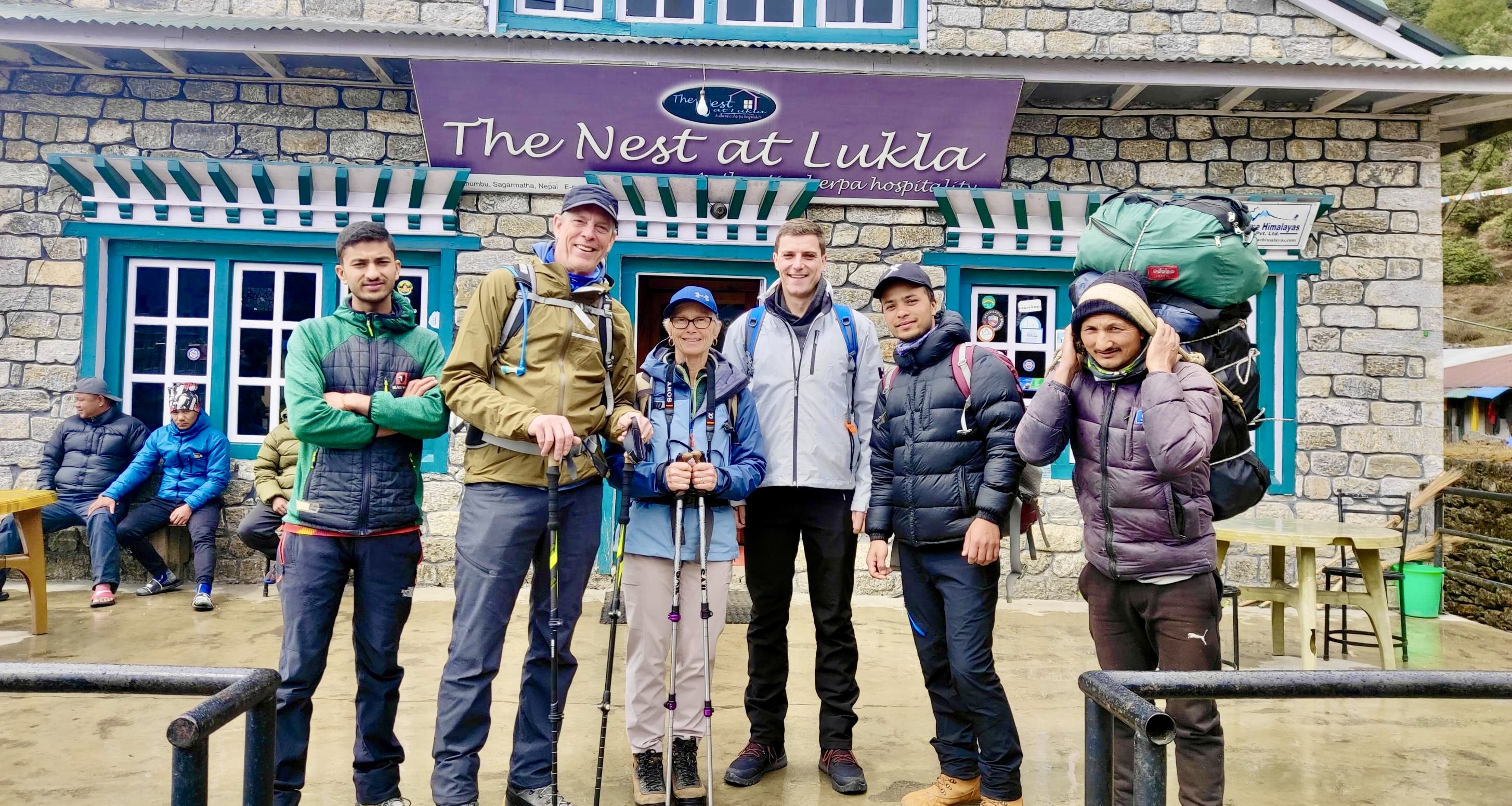
We arrange private transfers directly from Lukla to Kathmandu's finest spas and hotels. Soothe trek-weary muscles with traditional Himalayan hot stone therapy, indulge in aromatherapy treatments specifically designed for altitude recovery, or simply unwind in the hydrotherapy pools of Kathmandu's luxury hotels.
Many clients choose our two-day Dhulikhel Mountain Resort package, offering panoramic Himalayan views without the hiking. Others prefer our jungle extension in Chitwan National Park, where wildlife safaris replace mountain trails and private cottages offer a different kind of wilderness experience.
Your journey through the Everest Base Camp and Gokyo Valley Trek is more than just a physical adventure; it's a transformative experience that combines breathtaking landscapes, rich cultural encounters, and personal achievement. From the essential preparations before departure to the daily progression through varied terrains, stunning highlights like Kala Patthar's sunrise views, and the serene beauty of Gokyo's turquoise lakes, every aspect of this trek creates lasting memories. The comfortable teahouses, authentic Sherpa hospitality, and opportunities for spectacular photography further enhance this once-in-a-lifetime expedition.
Embark on this Himalayan adventure with Luxury Holidays Nepal to experience the perfect blend of challenge and comfort. Our expert guides, carefully planned itineraries, and premium services ensure you can focus on immersing yourself in the majesty of the world's highest mountain range while we handle the logistics. Whether you're an experienced trekker or embarking on your first high-altitude journey, the Everest Base Camp and Gokyo Valley Trek awaits to provide you with stories and photographs you'll treasure for a lifetime. Book your trek today and take the first step toward standing in the shadow of Everest.
Contact Luxury Holidays Nepal to craft your perfect Nepalese journey today.
If you need any further information, please contact us by email: [email protected], Phone: +977- 985 100 5129 (WhatsApp).

